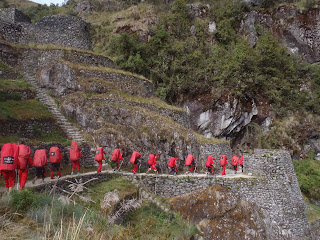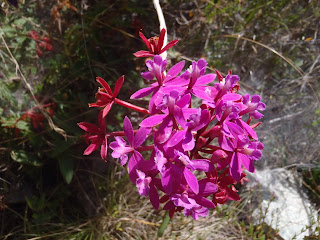Particularly difficult would be to explain that ink didn’t come into the equation at all. The Inca people did not use any ink because they had neither developed nor acquired the technology of writing. Instead, verbal messages were carried by relay runners called Chasqui. When they weren’t running messages, the Chasqui resided at specific relay stations along a network of high quality roads that tracked improbably through the mountains, awaiting the sound of a horn blast that indicated a runner was arriving with a relay message. The Inca Trail hiked by tourists today is built on the foundations of one of these roads.
The Inca’s first encounter with the kind of ink you write with is a fateful matter of historical record, because their first encounter with ink was also their first encounter with Christian fundamentalism. In 1532 the Inca Emperor, Atahualpa, first met with the Spanish conquistadors who would soon make much of South America their property. Atahualpa offered the conquistadors a drink from a ceremonial flask. This custom was practiced throughout the Andes to indicate mutual respect, much like ‘shouting’ a friend a beer and having him ‘shout’ you one back. The Spanish had no intention of respecting heathen customs and refused to drink with him, showing him a bible instead. Atahualpa was insulted. He wasn’t going to be able to eat the pages, nor could he drink the ink.
In 2010 I was having ink trail problems of my own. Alix and I had been picked up from South American Explorers club by Ruben, our Inca Trail tour guide. We had driven for two hours out of Cusco when Alix looked at me suddenly with her eyes very wide open.
“You have our passports with you, right?” She said.
“No, I forgot to bring them.” I replied.
At our trek briefing four days previously, Ruben had carefully explained that it would be very important that we have our passports with us because our tickets were individually coded to our Passport ID numbers and we were required to show them at various control points along the trail. Piscacucho was the name of the control point at the start of the Inca Trail. At some point I had forgotten all about these details and packed what I thought was important for multi-day hiking; spare socks, underwear, snacks, a torch- that kind of thing. We lost four hours while we backtracked to Cuzco, picked up the passports, and headed off for the second time to .
Despite our lengthy delay, we arrived at Piscacucho a little after midday. Completing the administrative requirements, the three of us, Ruben, Alix and myself, crossed the bridge over the Urubamba river and headed off on the dusty trail that crept slowly upwards towards the village of Wayllabamba.
The trail begins!
We were quite lucky to have Ruben as our private guide. We had booked and paid for a group tour, which typically comprises two guides, sixteen tourists and around twenty-two porters. However, there was a workers’ strike on the day we were supposed to commence our hike and the road to Piscacucho was closed. We had to delay our start date by one day, and instead of a group tour it would be just the two of us, supported by our guide Ruben, Isidro the cook, and five porters, who had now hiked ahead of us to a campsite to set up for lunch.
Ruben explained the function of some of the ruins we passed along the way as well as pointing out some of the flowering plants and medicinal herbs that grew along the trail. Without other tourists to slow us down we had plenty of time to listen and learn, asking Ruben whatever questions we liked, and we still made good time along the trail.
Q'anabamba, the first ruin we passed
Looking back to Cerro Veronica
We arrived at the campsite for lunch by mid-afternoon. Accustomed to camping in a small tent by ourselves, we were a little overwhelmed by the service provided to us at the campsite. Isidro and the porters had set up a private kitchen/dining tent complete with gas cookers, table and chairs and wash basins of warm water and liquid soap with which to wash up prior to eating. We were served a 3-course lunch. We felt like royalty. The rest of the afternoon passed with some pleasant hiking up to Wayllabamba. We had hiked a fairly casual 11km in around 5 hours.
The ruins at Willcarakay
The second day of hiking was much tougher than the first. In the morning we hiked 9km up from Wayllabamba (at approx 3000 metres above sea level) to a spurline between two mountains called Dead Woman’s Pass (4215m a.sl.). This steep ascent left many hikers gasping for breath on their frequent rest stops. Alix and I felt pretty good about our progress, after a couple of weeks ‘at altitude’ in Bolivia we were in no danger of altitude sickness and our slog up the trail was fairly steady. Once we caught our breath and looked around, the scenery was magnificent.
Success! The first pass is reached
And that's the first pass after a few more hours of walking
How's that for a spurline?
In the afternoon of our second day of hiking we arrived at a ruin named Runqurukay, several km’s further down the trail from Dead Woman’s Pass. Ruben stopped to explain to us that this ruined Inca building may once have been a relay station for the Chasqui messengers. In an attempt to better understand the speed at which a Chasqui relay might have carried messages along the Inca trail, a foot race is held annually along the trail between the start of the Inca Trail at Piscacucho and the ruin, Runqurukay. The speed record in this race is held by an Inca trail porter, who ran the distance in 3 hours and 45 minutes. It came as no surprise that the record was held by a porter. We had just hiked this same distance in around 12 hours over two days, and along the trail we had been overtaken many times by skinny brown men in dirty shorts and sandals, jogging past us carrying huge loads of equipment on their backs.
Runqurukay
The "Red Ants" - porters from another tour company - pass by the ruins at tongue-twisting Phuyupatamarka
Having tackled the steepest part of the trail on day two, day three was much easier as well as visually stunning. The peak of Salkantay mountain loomed white and majestic in the distance, and Ruben pointed out orchids growing along the way. The climate changed from the hot and dusty highlands to cool rainforest as we hiked down towards the steeply terraced ruins of another Inca ruin named Winay Wayna.
Sunrise on the third day
Salkantay mountain
Stunning orchids lined the trail
The high jungle begins
One of the Inca tunnels along the trail
At Winay Wayna
Having hiked quite quickly along the trail, I had the opportunity to sit with Alix and drink a couple of beers in the afternoon while watching the ruins do nothing in their stationary magnificence. Apart from being amazing to look at, the terraces were a practical feat of agricultural science. Like enormous window boxes, the terraces were constructed with excellent drainage, irrigation and soil quality and were used by the Incas to plant their crops.
After a tranquil hour staring at Winay Wayna, the ink trail caught up with us. Some national park officials were politely telling us to move on- we weren’t supposed to be drinking beer at the ruin site, despite there being a lodge from which to purchase it nearby. The ink trail was catching up with our support crew as well- half a dozen tourism officials with clipboards and serious expressions had materialised and they interrogated our cook, Isidro, and our porters about rubbish disposal, water and gas consumption, and so forth. The clipboard people looked clean, well-rested and urbane. They had probably gotten off the bus at Machu Picchu and walked into the Winay Wayna campsite from the opposite direction to us, so they had not put in any hard yards to get there.
One of the clipboard people interviewed Alix about the service we were receiving and she put in a good word for our crew. For three days these blokes had hiked in front of us carrying 25kg each, set up a small civilisation and prepared a three-course meal at every meal time, and broken it all down again for us once it was time to move on. Tired from doing the hike myself, it struck me as rather absurd that these men, who had hiked for three days faster than us, carrying more than us, should be answerable to soft-looking people with clipboards.
The last day of our Inca Trail trek was a long and satisfying one. We woke at 3.45am, breakfasted at 4.10, headed to (yet another) control point and on to Intipunku- the Sun Gate. From the Sun Gate we descended to Machu Picchu to be greeted by the most magnificent sunrise I have ever seen. It looks, from the top of Machu Picchu, just like the sun is a gigantic spotlight created specifically for the purpose of a slow reveal of the ruined city itself.
The sun hits Huayna Picchu
We spent the whole day thoroughly exploring the ruins, and this sunrise was the undisputed highlight of the trek for me. At sunrise you can marvel that such a place was ever built at all. There is a ruined temple here where once a year, on the Winter solstice, the first rays of the morning sun fall perfectly between two cracks in the central ceremonial stone. Elsewhere in the ruined city there is a carved stone plinth where twice each year on the Spring and Autumnal equinoxes, the central stone protrusion casts no shadow onto the plinth at all, but at all other times of the year, it does. Another temple has only a giant skylight for a roof and stone bowls carved into the floor. When filled with water, these bowls reflect the star-studded sky at night time. Historians believe that this allowed Inca priests to track the passage of the seasons as the sky shifted over time.
The Temple of the Sun
Double doorways like this signify "an important place"
These stone "bowls" reflect the night sky
Machu Picchu naturally captures the imagination. The buildings seem fused to the mountainside, harmonious with the shapes of nature. The Incas combined engineering skill with respect for the asymmetrical shapes of the earth to create a city that is both functional and beautiful, both practical science and work of art. There is a fusion of religion and astronomy in the temples here that remind us suddenly that there is no uniform, straight historical line from ‘primitive’ to ‘modern’ that all civilisations advance along.
The classic Machu Picchu view
Machu Picchu as viewed from Huayna Picchu
Llamas freely graze among the ruins of Machu Picchu
To finish this blog I feel compelled to write something clever-sounding about ink again to wrap up the theme I began with. However, I’m writing this blog on a computer and you are probably reading it on one, so if we had no ink between us we wouldn’t be at any disadvantage whatsoever. Walking amongst the ruins of Machu Picchu, it is easy to imagine that before the Spanish arrived and brought ink with them, the Incas felt that way about how they were getting along in the world, too.






















No comments:
Post a Comment